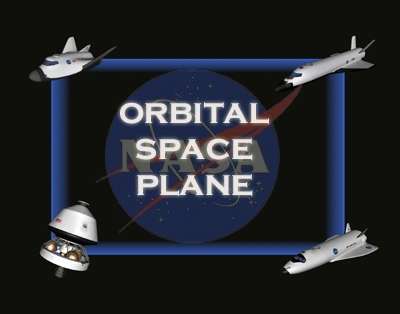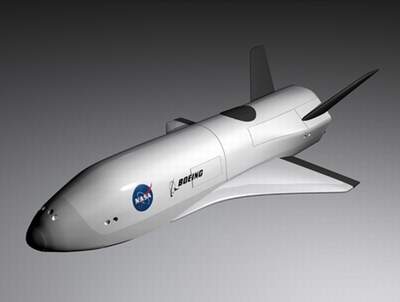Race To Complete Plans For Shuttle Replacement
 Nobody is sure what the Orbital
Space Plane will finally look like -- whether it'll be a winged
vehicle or a capsule. But one thing is for certain. The OSP is on
the fast-track.
Nobody is sure what the Orbital
Space Plane will finally look like -- whether it'll be a winged
vehicle or a capsule. But one thing is for certain. The OSP is on
the fast-track.
By 2008, the OSP is supposed to be up and flying as a rescue
vehicle for the International Space Station. By 2012, it's supposed
to be ready for two-way crew transfers.
"We're making progress, a lot of good progress," says Dennis
Smith, Orbital Space Plane program manager at NASA's Marshall Space
Flight Center in Huntsville (AL). "The contractor teams are
performing well and they are working hard. We are treating this as
a kind of partnership, and we're working well together."
Smith says the OSP is designed as an economy model. NASA doesn't
plan to spend any more than $13 billion on its development before
2009. "We're the first program that is being implemented under
full-cost accounting," says Smith.
But not everyone is happy with the OSP. Some see it as the
ultimate in retro-engineering. "It's a giant leap backwards,"
complains one space industry analyst. "NASA has an open checkbook
right now to get the shuttle flying. The problem is that they are
looking for the cheapest solution in terms of a backup, and that
would be the OSP. But even that's not cheap."

The skepticism extends to some offices on Capitol Hill.
Congressmen Sherwood Boehlert (R-NY) and Ralph Hall (D-TX) lead the
House Science Committee. "Mr. Hall and I have called on NASA not to
move ahead yet with a Request for Proposals for the Orbital Space
Plane," says Boehlert, speaking at a forum on NASA's future. "We're
not, by the way, calling for a complete halt to the program, but we
don't want to start taking steps that seem irrevocable."
Indeed, even as companies like Lockheed-Martin put manpower and
resources on the line for the OSP, they're doing it with frequent
glances over their corporate shoulders. "We're worried as much as
keeping the program sold at NASA Headquarters and on Capitol Hill
as we are about winning the program," says former astronaut Michael
Coates, now a VP for Advanced Space Transportation at
Lockheed-Martin.
What Will It Look Like?
So far, the capsule advocates seem to be winning -- especially
if one major goal is to get the OSP up and running ASAP. "A winged
vehicle would take a long time to develop," says Coates.
Dale Myers agrees. He was a key engineer on the Apollo project.
Testifying before the House Subcommittee on Space and Aeronautics
earlier this year, Myers said, "It appears to me that the robust
launch escape system of Apollo, which worked over a wide range from
the launch pad to high altitude, will be hard to beat in a winged
vehicle."

All eyes are on NASA now. John Logsdon, Director of the Space
Policy Institute at George Washington University's Elliott School
of International Affairs, was a member of the Columbia Accident
Investigation Board (CAIB). "The OSP program is extremely important
in terms of reflecting, first of all, whether NASA's really going
to change its behavior and not try to pursue a project that's
driven by [NASA] center interests and contractor interests but is
driven by national interests. I fall back on what the CAIB said.
Crew transfer to and from the space station, maximized for safety,
period. There's no reason in the world that should cost $12
billion."
Whether NASA plans to make the OSP a simple craft dedicated to a
simple purpose -- rotating crews and shuttling small amounts of
cargo to the ISS -- is still up in the air. The question for
Logsdon and others who think like him is: Will this project become
something like a Congressional spending bill -- so overloaded with
pork and wishful thinking that it can't even get off the
ground?
 Sierra Space Repositions Dream Chaser for First Mission
Sierra Space Repositions Dream Chaser for First Mission ANN's Daily Aero-Term (05.10.24): Takeoff Roll
ANN's Daily Aero-Term (05.10.24): Takeoff Roll Aero-News: Quote of the Day (05.10.24)
Aero-News: Quote of the Day (05.10.24) Aero-News: Quote of the Day (05.11.24)
Aero-News: Quote of the Day (05.11.24) ANN's Daily Aero-Term (05.11.24): IDENT Feature
ANN's Daily Aero-Term (05.11.24): IDENT Feature





